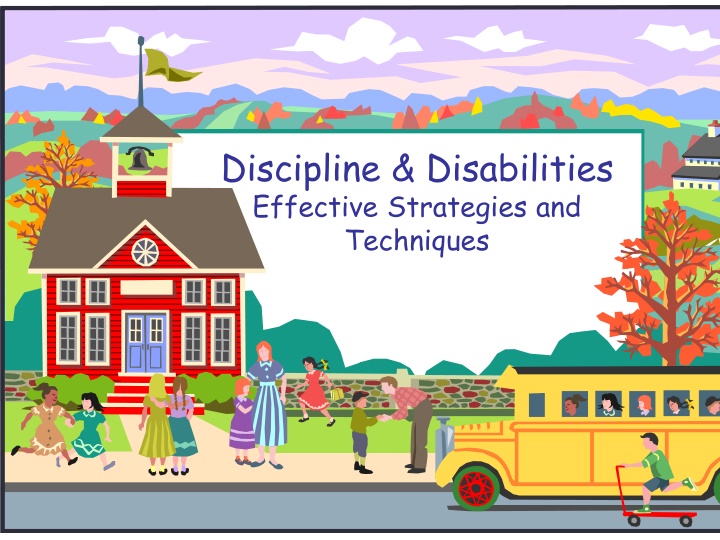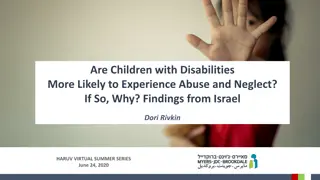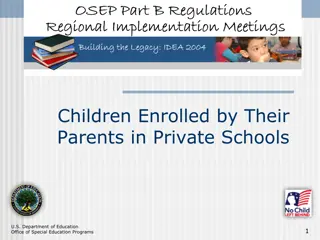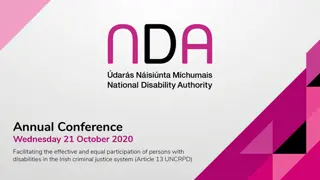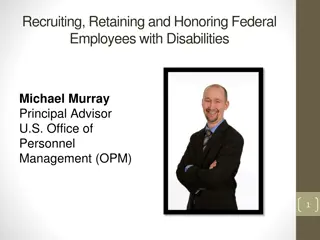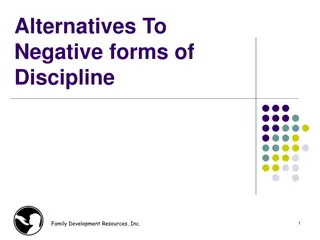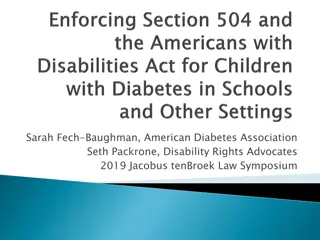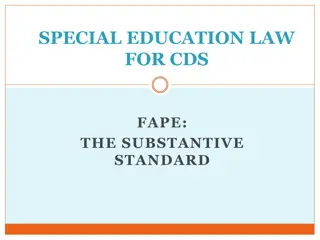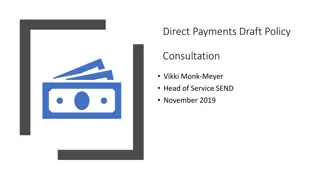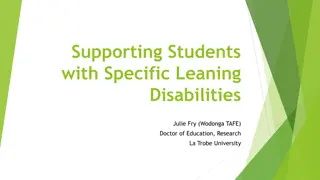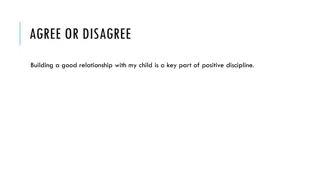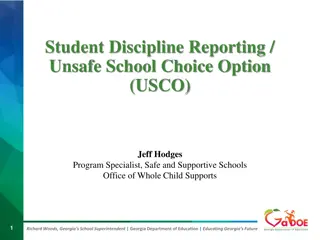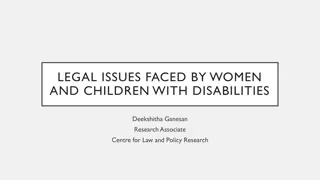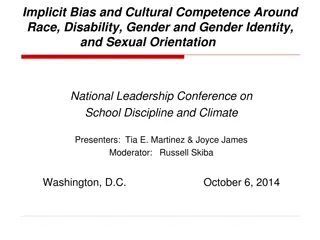Effective Discipline and Strategies for Children with Disabilities
Explore effective discipline strategies and techniques for children with disabilities, presented by experts in special education and psychology. Learn about the purpose of discipline, key tenets to keep in mind, common behavioral difficulties, and how to understand and address challenging behaviors in children with and without ASD.
Download Presentation

Please find below an Image/Link to download the presentation.
The content on the website is provided AS IS for your information and personal use only. It may not be sold, licensed, or shared on other websites without obtaining consent from the author.If you encounter any issues during the download, it is possible that the publisher has removed the file from their server.
You are allowed to download the files provided on this website for personal or commercial use, subject to the condition that they are used lawfully. All files are the property of their respective owners.
The content on the website is provided AS IS for your information and personal use only. It may not be sold, licensed, or shared on other websites without obtaining consent from the author.
E N D
Presentation Transcript
Discipline & Disabilities Effective Strategies and Techniques
About the Presenters Syliva Garcia Special Education Interventionist Jennifer Key, Ph.D. Licensed Psychologist, Licensed Specialist in School Psychology Valerie Weed LISD Practicum Student Doctoral Candidate Texas Woman s University
Purpose of Discipline For Children who do not have ASD For Children who have ASD
Tenets to Keep in Mind Children want to behave and do what is expected of them If we want children to be successful behaviorally, we must teach them the skills to be successful Successful behaviors are not always appropriate behaviors Success is dependent upon the child s ability to adapt to his/her environment Behavioral Skills are not the equivalent of academic skills
Common Behavioral Difficulties Transitions From preferred to non-preferred activities or settings Difficulties surrounding family or social activities or routines Mealtimes (remaining at the table, engaging) Bedtime & sleep Toilet training Avoidance behaviors Sensory sensitivities (food refusal, avoiding specific locations or tasks)
First, Determine the Function To better understand why behavior occurs, we need to understand what purpose the behavior serves. What happens immediately before the challenging behavior occurs? What happens as a result of the challenging behavior?
Why do they do this? To understand children s behavior we need to figure out why they are doing what they are doing. What is the function of their behavior? What happens immediately before the challenging behavior, such as a tantrum or biting, occurs? What happens as a result of the challenging behavior? Functions of behavior usually include getting something you want (attention, toys, food) or getting out of or away from something you don t want (clean up, bath time, demands).
Functions of Behaviors Ask yourself what is a possible function of the behavior. Examples of possible functions: Attention Avoiding an activity Getting something you want
The ABCs of Behavior A=what happens before the behavior. B=the behavior C=what happens after the behavior. To change the B, we need to Teach the B Change the A Change the C
Things to Pay Attention To How often do the behaviors happen? How long have the behaviors been going on? How severe/intense are the behaviors? How many different problem behaviors does the child display? Where/When do the behaviors happen? What else may be going on that could explain the behaviors?
Changing the befores Modify what happens directly before a challenging behavior occurs. Expectations Be clear Communicate Be flexible Be reasonable Change the way the direction is given. Timing Choices The Premack Principle or Grandma s rule
Some more befores to consider Alter the difficulty of the task Break it up Offer assistance Make it a game Provide attention before the behavior begins Identify hot spots Give attention to positive behaviors Accentuate the positive (even if it is not there yet) Use behavioral momentum
Changing the afters Modify what happens directly after the challenging behavior occurs. Enforce demands and requests with prompts and physical assistance. Provide limited attention and ignore when possible. Promote and support use of appropriate skills to get something you want. Reward those behaviors you want to see again. The afters or consequences should: Be immediate Be specific Be consistent
Other Changes Teach responses children can use instead of using challenging behaviors. Provide opportunities for children to use their new skills. Reinforce children s use of skills. Teach children how to communicate without using challenging behavior.
Some rules to remember Behaviors that are reinforced positively (rewards, smiles, praise) are more likely to occur again. Behaviors that are not reinforced positively are less likely to occur again. Behaviors that are reinforced negatively are more likely (allowed to escape) to occur again. Behaviors that are not reinforced negatively are less likely to occur again.
Modifications Modify your reactions to the challenging behavior. If Julie tantrums every time you ask her to turn off the TV and get ready for bed, and she is sent to time-out every time she tantrums, she is avoiding bedtime by going to time-out. Julie is getting a desired outcome as a result of her challenging behavior. Instead, ignore the tantrum and keep the demand that she get ready for bed
What can you do? Reinforce appropriate behavior. Follow rules and routines. Provide children with opportunities to make choices.
What can you do? Teach children to communicate feelings in appropriate ways. Explain appropriate ways to express feelings Teach words for different feelings. Teach how to recognize feelings in self an in others
Giving Effective Commands Make sure you mean it Do not present the command as a question Do not give too many commands at once Tell your child what to do rather than what not to do Avoid competing distractions when giving commands Be cautious of commands that involve the concept of time
Reinforcement vs. Punishment Reinforcement - strengthens or increases the probability of a specific response Positive - Adding a stimulus, such as a treat or reward, in order to increase a response Negative Taking away a stimulus, such as stop nagging after trash is taken out Punishment adding an aversive stimulus to decrease unwanted behavior
Extinction Removing a stimulus to decrease a behavior; withhold the reinforcers that may be maintaining the behaviors The connection between the behavior and the consequence ceases Useful for behaviors such as: whining, complaining, tantruming, attention- seeking behaviors
Shaping/Successive Approximations Shaping/Successive Approximations Can lead to the acquisition of new behaviors by rewarding behaviors that move toward the desired behavior in some way Useful for behaviors such as: teaching social initiations, increasing participation in activities, taking initiative, teaching communication skills, toilet training
Chaining Teaches a sequence of behaviors by successively rewarding each individual step & training the learner to put the steps together Useful for behaviors such as: social initiations (go to peer, make eye contact, say hello)
Positive Consequence Strategies Manipulation of consequences may be used to influence a child s motivation, and change long-standing behavior patterns. Manage consequences so that reinforcement is given for desired behavior and withheld in response to problem behavior.
Positive Consequence Strategies
Reinforcement Schedules Continuous Schedules Fixed Ratio Fixed Interval Variable schedules Variable Ratio Variable Interval
Other Changes Teach responses children can use instead of using challenging behaviors. Provide opportunities for children to use their new skills. Reinforce children s use of skills. Teach children how to communicate without using challenging behavior.
Behavioral Contracts Choose behavior(s) to reinforce Rank or order behaviors by ease of time, effort, and compliance Construct list of privileges Specific, desired by child, but must be enforced by parent Written document to be signed by parent and child
Behavior Management Plans READY: Develop a plan 6 steps to define who, what, when, where, and how? SET: Outline the plan to follow each day Prepare materials. GO: Use praise Follow through on the plan Be consistent
Ready - Step 1: Who Who needs the plan? 1 or more of your children NOTE: The more issues/behaviors you can address and prevent early on, the better.
Step 2: What What do I want them to do? Define the target behavior (specific, observable, simple) Examples: Be nice = Use materials together by handing them to each other (not throwing). Talk to each other to solve a problem (not hitting or yelling). Clean up = Pick up the toys or other materials used during the activity and put them in the right place on the shelf.
Step 3 - Where/when Where do they need to do the behavior? Setting(s) Examples: In the living area = While in the living area, or at the dinner table, children will
Step 4: How often? How often do the children have to do the behavior? Number of times during the day (or activity or week) Be reasonable Example All day = I will choose 3 times during the day (e.g., center time, lunch, circle time) to identify children who are
Step 5: What reward? What will the children receive when they do the behavior? Desired by the children Simple to follow through with Example Play money = (be more creative?) When I see a child doing X, they will receive one dollar. If they receive four or five dollars during the day, he may buy something from his reinforcer menu that night.
Step 6: Put it together Put all of your steps together and evaluate it. Does it make sense? Is it possible to do? (easy to carry out?) Would a family member or babysitter be able to follow it? Will the children understand it? Can I explain it to the children?
Get SET! Be creative: Develop a theme iPhone and iPad Apps are great tools Gather materials Tokens, charts, rewards Visual reminders for children Visual reminders for you List and review rules Should include the behavior you are looking for
Now you are ready to GO! Remember Be immediate Be positive Be specific You earn a point for picking up all the toys in your center. Good job! Be consistent Monitor when you say you will Reward when you say you will
Multimedia Resources Behavior Journal ($9.99) iReward ($4.99) iReward Chart iEarnedThat Chore Pad Lite (Free) Earn It Stars
App Websites http://momswithapps.com/2011/03/31/app- friday-autism-awareness/ http://www.autismspeaks.org/family- services/resource-library/autism-apps http://www.matchacollege.com/blog/2011/40- amazing-ipad-apps-for-the-learning-disabled/ http://www.stellamarie.com/index.php/Android/ apps-i-found-on-net http://www.ipadsforeducation.vic.edu.au/userfil es/files/DEECD%20iPad%20support%20bookl et%20for%20special%20education.pdf
